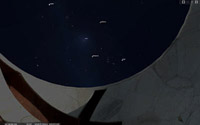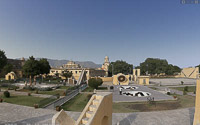O usuario contribuíu coas paisaxes
Temos paisaxes dos sete continentes (no modelo de sete continentes) incluíndo a Antártida!
paisaxes:
Asia
| Screenshot not available |
Angkor Wat, Cambodia |
0.9+ |
| Paul Bourke, Peter Murphy |
N/A |
English |
| Angkor Wat, Cambodia |
| Screenshot not available |
Bakheng, Cambodia |
0.9+ |
| Paul Bourke, Peter Murphy |
N/A |
English |
| Bakheng, Cambodia |
| Screenshot not available |
Bayon, Cambodia |
0.9+ |
| Paul Bourke, Peter Murphy |
N/A |
English |
| Bayon, Cambodia |
 |
Jantar Mantar at Delhi |
0.9+ |
| Barry Perlus |
CC BY-NC-ND 4.0 |
English |
| Between 1727 and 1734 Maharajah Jai Singh II of Jaipur constructed five astronomical observatories in west central India. The observatories, or "Jantar Mantars" as they are commonly known, incorporate multiple buildings of unique form, each with a specialized function for astronomical measurement. For more information on these fascinating scientific and architectural works see jantarmantar.org. |
| Screenshot not available |
Mount Everest |
0.9+ |
| Makc |
© |
English |
| Amazing parorama of the summit of Mount Everest, 8.85 km above sea level. Roddy Mackenzie, who climbed the mountain in 1989, captured the image. |
 |
The Jai Prakash Instrument at the Jaipur Observatory |
0.9+ |
| Barry Perlus |
CC BY-NC-ND 4.0 |
English |
| Between 1727 and 1734 Maharajah Jai Singh II of Jaipur constructed five astronomical observatories in west central India. The observatories, or "Jantar Mantars" as they are commonly known, incorporate multiple buildings of unique form, each with a specialized function for astronomical measurement. For more information on these fascinating scientific and architectural works see jantarmantar.org. |
 |
Jantar Mantar at Jaipur |
0.9+ |
| Barry Perlus |
CC BY-NC-ND 4.0 |
English |
| Between 1727 and 1734 Maharajah Jai Singh II of Jaipur constructed five astronomical observatories in west central India. The observatories, or "Jantar Mantars" as they are commonly known, incorporate multiple buildings of unique form, each with a specialized function for astronomical measurement. For more information on these fascinating scientific and architectural works see jantarmantar.org. |
| Screenshot not available |
Jantar Mantar |
0.9+ |
| Barry Perlus & Stellarium team |
CC BY-NC-SA 3.0 |
English |
| Professor Barry Perlus of Cornell University allowed us to use his panoramic photography of one of the Jantar Mantars in India to create this landscape. For more information on these fascinating scientific and architectural works see jantarmantar.org. |
 |
LAMOST |
0.9+ |
| John Wei |
N/A |
English |
| The Large Sky Area Multi-Object Fibre Spectroscopic Telescope (LAMOST), also known as the Guoshoujing Telescope is a meridian reflecting Schmidt telescope, located in Xinglong Station, Hebei Province, China. |









